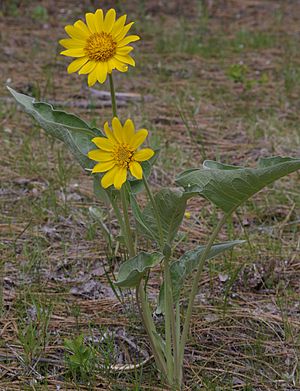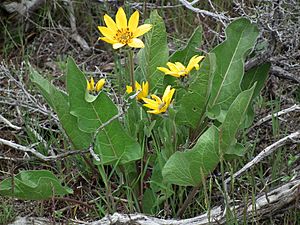Balsamroot facts for kids
Quick facts for kids Balsamroot |
|
|---|---|
 |
|
| Balsamorhiza sagittata | |
| Scientific classification |
|
| Kingdom: | Plantae |
| Clade: | Tracheophytes |
| Clade: | Angiosperms |
| Clade: | Eudicots |
| Clade: | Asterids |
| Order: | Asterales |
| Family: | Asteraceae |
| Subfamily: | Asteroideae |
| Supertribe: | Helianthodae |
| Tribe: | Heliantheae |
| Genus: | Balsamorhiza Hook. ex Nutt. |
Balsamroots are a type of plant found in the sunflower family. They are known for their bright yellow, sunflower-like flowers. These plants are perennials, meaning they live for more than two years. They have thick, fleshy roots and strong stems. Balsamroots grow naturally in western North America, including parts of the United States and Canada.
Native Americans used the sticky sap from balsamroots. They put it on small cuts to help them heal. The whole plant can be eaten and has nutrients. However, it can taste bitter and has a strong pine smell. The large roots of the Balsamorhiza sagittata plant were very important. Native Americans would dig them up, dry them, and grind them into a starchy flour. This flour was used when other foods were hard to find. The roots are said to be much tastier and less bitter than the parts of the plant that grow above ground.
Where Balsamroots Grow
Balsamroots like to grow on dry hillsides. You can also find them in open, dry meadows. They are common throughout the Mountain West region of North America.
It can be easy to mix up balsamroots with another plant called Wyethia, also known as Mule's ears. Both plants look quite similar. They also flower in similar ways. But you can tell them apart by looking at their leaves. Wyethia plants have very sharp, spear-shaped leaves. Balsamroot leaves, however, often look fuzzy and silver-gray. Balsamorhiza sagittata is the most common balsamroot species. It grows widely across the Mountain West.
Balsamroots and Wildlife
Animals and livestock enjoy eating balsamroots. But if too many animals graze in an area, the number of balsamroot plants can go down. These plants used to cover large parts of the dry western lands in spring. Now, they are less common in some places, like the Snake River Plains.
The health of balsamroot plants can show how healthy a pasture is. If there are fewer plants and flowers, it might mean the land is being overused. Hillsides once full of balsamroots, bunchgrasses, and sagebrush can change. They might become covered in weeds like cheatgrass if animals eat too much. This can harm the plants and their ability to grow back.
Types of Balsamroot Plants
There are about 13 different kinds of balsamroot plants. There are also two nothospecies, which are natural hybrids. Here are some of them:
- Balsamorhiza × bonseri - Found in Washington State
- Balsamorhiza careyana - Carey's balsamroot - Found in Washington and Oregon
- Balsamorhiza deltoidea - Deltoid balsamroot - Found in British Columbia, Washington, Oregon, and California
- Balsamorhiza hispidula - Found in Idaho, Montana, Wyoming, Oregon, Nevada, Colorado, Utah, and Arizona
- Balsamorhiza hookeri - Hooker's balsamroot - Found in Washington, Oregon, California, Nevada, Utah, and Arizona
- Balsamorhiza incana - Hoary balsamroot - Found in Idaho, Montana, Wyoming, Oregon, and Washington
- Balsamorhiza lanata - Lanate balsamroot - Found in Oregon and California
- Balsamorhiza macrolepis - California balsamroot - Found in California
- Balsamorhiza macrophylla - Cutleaf balsamroot - Found in Idaho, Montana, Wyoming, Oregon, and Utah
- Balsamorhiza rosea - Rosy balsamroot - Found in Washington and Oregon
- Balsamorhiza sagittata - Arrowleaf balsamroot - Found in British Columbia, Alberta, and much of the western USA
- Balsamorhiza sericea - Silky balsamroot - Found in Oregon and California
- Balsamorhiza serrata - Serrate balsamroot or Toothed balsamroot - Found in Nevada, Washington, Oregon, and California
- Balsamorhiza terebinthacea - Found in Washington, Oregon, and California
- Balsamorhiza × tomentosa - Found in Idaho, Montana, Wyoming, Washington, and Oregon
See also
- In Spanish: Balsamorhiza para niños


